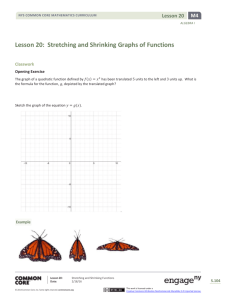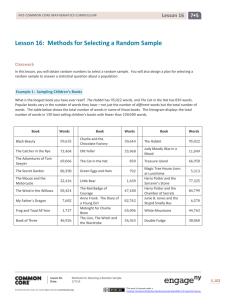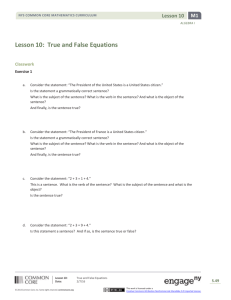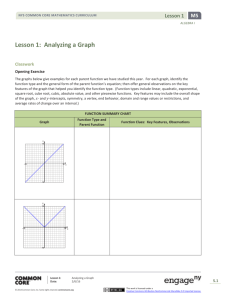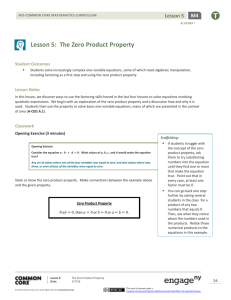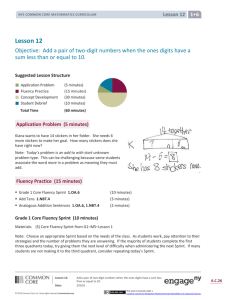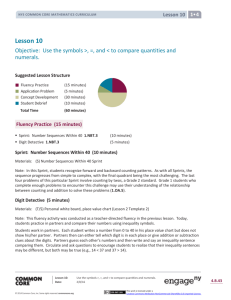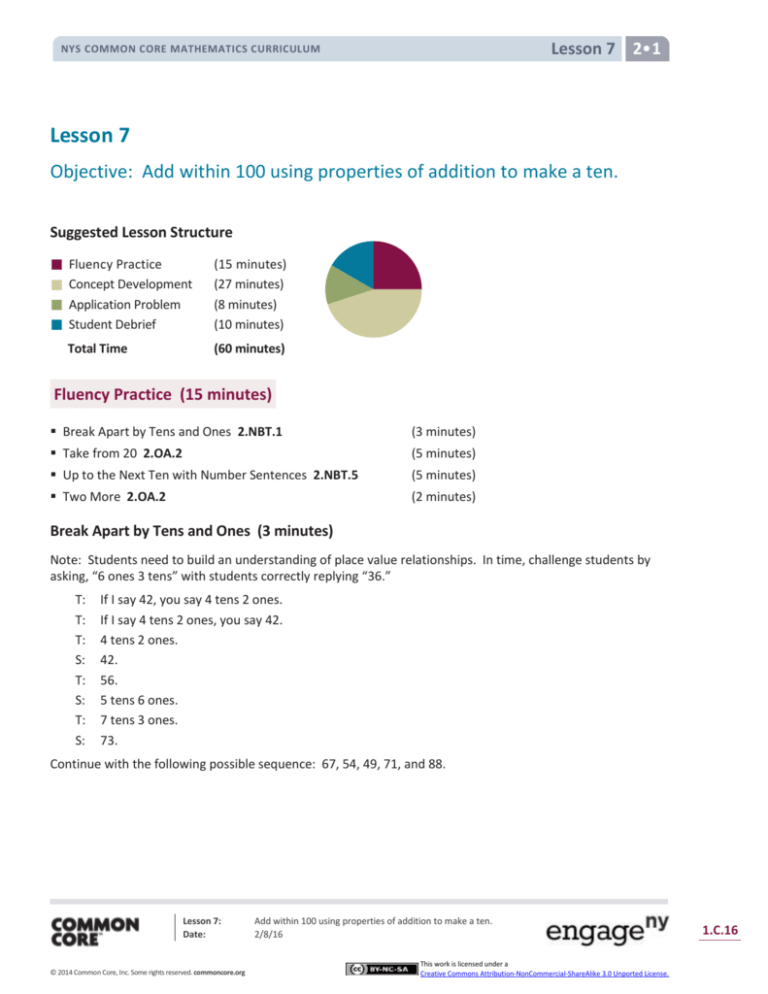
Lesson 7 2•1
NYS COMMON CORE MATHEMATICS CURRICULUM
Lesson 7
Objective: Add within 100 using properties of addition to make a ten.
Suggested Lesson Structure
Fluency Practice
Concept Development
Application Problem
Student Debrief
Total Time
(15 minutes)
(27 minutes)
(8 minutes)
(10 minutes)
(60 minutes)
Fluency Practice (15 minutes)
Break Apart by Tens and Ones 2.NBT.1
(3 minutes)
Take from 20 2.OA.2
(5 minutes)
Up to the Next Ten with Number Sentences 2.NBT.5
(5 minutes)
Two More 2.OA.2
(2 minutes)
Break Apart by Tens and Ones (3 minutes)
Note: Students need to build an understanding of place value relationships. In time, challenge students by
asking, “6 ones 3 tens” with students correctly replying “36.”
T:
T:
T:
S:
T:
S:
T:
S:
If I say 42, you say 4 tens 2 ones.
If I say 4 tens 2 ones, you say 42.
4 tens 2 ones.
42.
56.
5 tens 6 ones.
7 tens 3 ones.
73.
Continue with the following possible sequence: 67, 54, 49, 71, and 88.
Lesson 7:
Date:
© 2014 Common Core, Inc. Some rights reserved. commoncore.org
Add within 100 using properties of addition to make a ten.
2/8/16
This work is licensed under a
Creative Commons Attribution-NonCommercial-ShareAlike 3.0 Unported License.
1.C.16
Lesson 7 2•1
NYS COMMON CORE MATHEMATICS CURRICULUM
Take from 20 (5 minutes)
Materials: (S) Personal white boards
Note: Students use personal white boards to see the connection between taking from ten and taking from a
multiple of ten.
T:
T:
S:
T:
S:
I say 2, you say 8, to take the number I say from 10. Then, write the number sentence and wait for
my signal to show it.
6.
4. (Write number sentence.)
Show your board.
(Show 10 – 6 = 4.)
Continue with the following possible sequence: 7, 9, and 5.
T:
T:
S:
T:
S:
This time instead of taking from 10, let’s take from 20. Ready?
1.
19. (Write number sentence.)
Show your board.
(Show 20 – 1 = 19.)
Continue with the following possible sequence: 5, 6, 8, and 3.
Up to the Next Ten with Number Sentences (5 minutes)
Note: Students remember the importance of their make ten
facts with larger numbers. By saying up it indicates an addition
sentence.
T:
T:
T:
S:
T:
S:
T:
S:
T:
S:
If I say, “18 up,” you say “2.”
If I say, “Give me the number sentence,” you say,
“18 + 2 = 20.” Ready?
7 up.
3.
Give me the number sentence.
7 + 3 = 10.
17 up.
3.
Give me the number sentence.
17 + 3 = 20.
NOTES ON
MULTIPLE MEANS OF
ACTION AND
EXPRESSION:
During Fluency Practice, provide a
variety of ways for students to
respond: oral, choral, student personal
white boards for number sentences,
concrete models (e.g., fingers,
Rekenrek), or pictorial models (e.g.,
ten-frame). Vary choral response with
written response on student boards to
support English language learners.
Model how the use of the ten-frame
can help students answer problems
such as 57 up.
Continue with the following possible sequence: 57 up, 97 up, 6
up, 4 up, 26 up, 24 up, 54 up, 74 up, 1 up, 9 up, 31 up, 61 up,
and 81 up.
Lesson 7:
Date:
© 2014 Common Core, Inc. Some rights reserved. commoncore.org
Add within 100 using properties of addition to make a ten.
2/8/16
This work is licensed under a
Creative Commons Attribution-NonCommercial-ShareAlike 3.0 Unported License.
1.C.17
Lesson 7 2•1
NYS COMMON CORE MATHEMATICS CURRICULUM
Two More (2 minutes)
Note: Students are eased into crossing multiples of ten by asking for just 2 more.
T:
S:
For every number I say, you will say what number is 2 more. If I say 2, you say 4. Ready? 3.
5.
Continue with the following possible sequence: 6, 9, 8, 18, 38, 58, 78, 9, 19, 39, 59, and 79.
Concept Development (27 minutes)
Materials: (T) Ten-frame cards showing 10 (Lesson 3 Template), two-sided counters (S) Personal white board
Note: This lesson focuses on addition of two-digit and one-digit numbers crossing multiples of 10
(e.g., 38 + 4, 47 + 6, 78 + 5, 5 + 78).
T:
T:
S:
T:
S:
T:
S:
T:
S:
T:
S:
T:
S:
T:
S:
T:
S:
T:
S:
T:
S:
T:
S:
T:
(Present 12 counters as shown at right.)
7 + 5 = 12
7 + 3 (pause and point) + 2 is…?
12.
7 + 5 is…?
12.
(Lay down a ten-frame card.) 17 + 3 (pause) + 2 is…?
22.
17 + 5 = 22
17 + 5 is…?
22.
5 + 17 is…?
22.
(Lay down a ten-frame card.) 27 + 3 (pause) + 2 is…?
27 + 5 = 32
32.
27 + 5 is…? Let’s read them the Say Ten way.
7 + 5 = 1 ten 2. 1 ten 7 + 5 = 2 tens 2, 2 tens 7 + 5 = 3 tens 2.
What basic fact was used in all three problems?
7 + 5 = 12.
On your personal white boards, work with me to solve 87 + 5 without materials. First, bond 87 as 80
and 7.
(Write the bond.)
How did we bond 5 to make a ten (point to the materials)?
3 and 2.
Excellent. 7 needs 3 to make ten. Show me that second bond.
(Write the bond.)
We end up with 80 + 7 + 3 + 2. The answer is…?
Lesson 7:
Date:
© 2014 Common Core, Inc. Some rights reserved. commoncore.org
Add within 100 using properties of addition to make a ten.
2/8/16
This work is licensed under a
Creative Commons Attribution-NonCommercial-ShareAlike 3.0 Unported License.
1.C.18
Lesson 7 2•1
NYS COMMON CORE MATHEMATICS CURRICULUM
S:
T:
S:
T:
92.
Talk to your partner about how you know.
7 + 3 is 10, so it’s 80 + 10 + 2, 92. I know 7 + 5 is 12, so 80 + 12 is 92. I counted on, 80, 90, 92.
Try using the same strategy to solve 18 + 6 on your personal white board. Share if you get stuck.
Note: As students work, provide new problems as needed, varying the basic fact and increasing the number
of tens for some students (e.g., 15 + 6, 45 + 6, 5 + 76, 4 + 87) while giving the same basic fact and staying
under 5 tens for others who need more practice at a simpler level (e.g., 19 + 3, 29 + 3, 39 + 3). It is wise to
use the personal white board rather than pencil and paper at times as students are advancing into more
challenging territory. Work can quickly be erased and corrected, making error correction easy and more
conducive to perseverance.
Problem Set (10 minutes)
Students should do their personal best to complete the Problem Set within the allotted 10 minutes. For
some classes, it may be appropriate to modify the assignment by specifying which problems they work on
first. Some problems do not specify a method for solving. Students should solve these problems using the
RDW approach used for Application Problems.
Application Problem (8 minutes)
One box fits exactly 10 cans. On Monday, Maria packed (18, 78)
(see Multiple Means Note) cans into boxes, making sure to fill a
box before beginning a new one. On Tuesday she added 6 more
cans.
a. How many boxes were
completely filled then?
b. How many cans did
Maria pack in all?
c. Extension: How many
more cans did Maria
need to fill another
box?
NOTES ON
MULTIPLE MEANS OF
ENGAGEMENT:
“(18,78)” is an invitation to choose
numbers that are appropriate for
different learners. Students may lack
wisdom in their choice of numbers.
Better to initially guide them towards
the right choice for the skill set, with
the understanding that we are
coaching them towards becoming
wiser choosers.
Extension problems are always
accommodations for early finishers and
advanced learners.
Note: In this problem, students apply the strategy they learned in today’s lesson, using basic facts to bond
and make a ten when crossing multiples of ten. Students who are able to work without support may choose
to solve for the larger number, 78, while the teacher guides others using the smaller number, 18.
Lesson 7:
Date:
© 2014 Common Core, Inc. Some rights reserved. commoncore.org
Add within 100 using properties of addition to make a ten.
2/8/16
This work is licensed under a
Creative Commons Attribution-NonCommercial-ShareAlike 3.0 Unported License.
1.C.19
Lesson 7 2•1
NYS COMMON CORE MATHEMATICS CURRICULUM
Student Debrief (10 minutes)
Lesson Objective: Add within 100 using properties of
addition to make a ten.
The Student Debrief is intended to invite reflection and
active processing of the total lesson experience.
Invite students to review their solutions for the Problem
Set. They should check work by comparing answers
with a partner before going over answers as a class.
Look for misconceptions or misunderstandings that can
be addressed in the Debrief. Guide students in a
conversation to debrief the Problem Set and process
the lesson.
You may choose to use any combination of the
questions below to lead the discussion.
How does knowing 8 + 2 make 10 help you
solve 78 + 4?
Look at Problems 1 and 2. What is the
relationship between 78 + 4 and 58 + 5?
How did the basic fact 6 + 8 help you solve
Problems 4 and 5?
How does a ten-frame model help us with
learning to complete a 10 to add numbers to
100?
Think about our story problem with the cans
and the way that we solved problems with the
ten-frame model. Partner B, explain to Partner
A how the problems are the same.
Exit Ticket (3 minutes)
After the Student Debrief, instruct students to complete
the Exit Ticket. A review of their work will help you
assess the students’ understanding of the concepts that
were presented in the lesson today and plan more
effectively for future lessons. You may read the
questions aloud to the students.
Lesson 7:
Date:
© 2014 Common Core, Inc. Some rights reserved. commoncore.org
Add within 100 using properties of addition to make a ten.
2/8/16
This work is licensed under a
Creative Commons Attribution-NonCommercial-ShareAlike 3.0 Unported License.
1.C.20
Lesson 7 Problem Set 2•1
NYS COMMON CORE MATHEMATICS CURRICULUM
Name
Date
Solve the following problems. Draw your number bonds.
1. 78
70
+
4=
8 2
2. 58
+
5=
2
3. 54
+
6=
4. 88
+
2=
5. 26
+
8=
6. 48
+
6=
7. Fill in the blanks to make the number sentences true.
a.
9+1=
b. 8 +
= 10
10 + 2 =
10 +
19 + 3 =
8+
49 + 3 =
28 +
= 30
69 + 3 =
30 +
= 35
89 + 3 =
28 +
= 35
Lesson 7:
Date:
© 2014 Common Core, Inc. Some rights reserved. commoncore.org
= 15
= 15
Add within 100 using properties of addition to make a ten.
2/8/16
This work is licensed under a
Creative Commons Attribution-NonCommercial-ShareAlike 3.0 Unported License.
1.C.21
NYS COMMON CORE MATHEMATICS CURRICULUM
Lesson 7 Problem Set 2•1
Label each number sentence as true or false.
8. 22 + 8 = 20 + 10
9. 57 + 5 = 50 + 10 + 2
10. 83 + 9 = 80 + 10 + 1
11. 68 + 7 = 70 + 5
12. 88 + 9 = 90 + 6
13. Jorge saved 65 dollars last month. This month he saved 8 more dollars. How much
money does he have now?
Lesson 7:
Date:
© 2014 Common Core, Inc. Some rights reserved. commoncore.org
Add within 100 using properties of addition to make a ten.
2/8/16
This work is licensed under a
Creative Commons Attribution-NonCommercial-ShareAlike 3.0 Unported License.
1.C.22
Lesson 7 Exit Ticket 2•1
NYS COMMON CORE MATHEMATICS CURRICULUM
Name
Date
Solve the following problems. Draw your number bonds.
1. 28 + 4 =
2. 39 + 4 =
3. 27 + 9 =
4. 38 + 9 =
Lesson 7:
Date:
© 2014 Common Core, Inc. Some rights reserved. commoncore.org
Add within 100 using properties of addition to make a ten.
2/8/16
This work is licensed under a
Creative Commons Attribution-NonCommercial-ShareAlike 3.0 Unported License.
1.C.23
Lesson 7 Homework 2•1
NYS COMMON CORE MATHEMATICS CURRICULUM
Name
Date
Solve the following problems. Draw your number bonds.
1. 78
70
+
8 2
4 = _______
2. 58
+
5 = _______
2
3. 36
+
6 = _______
4. 26
+
7 = _______
5. 23
+
9 = _______
6. 44
+
9 = _______
7. 47
+
8 = _______
8. 68
+
8 = _______
9. 89
+
8 = _______
10. 77
Lesson 7:
Date:
© 2014 Common Core, Inc. Some rights reserved. commoncore.org
+
9 = _______
Add within 100 using properties of addition to make a ten.
2/8/16
This work is licensed under a
Creative Commons Attribution-NonCommercial-ShareAlike 3.0 Unported License.
1.C.24
NYS COMMON CORE MATHEMATICS CURRICULUM
Lesson 7 Homework 2•1
Label each number sentence as true or false.
11. 38 + 2 = 30 + 10
12. 57 + 5 = 50 + 10 + 2
13. 83 + 9 = 80 + 10 + 1
14. 64 + 7 = 70 + 1
15. 89 + 9 = 90 + 7
16. Anthony found 48 coins last month. This month he found 7 more coins. How many
coins does he have now?
Lesson 7:
Date:
© 2014 Common Core, Inc. Some rights reserved. commoncore.org
Add within 100 using properties of addition to make a ten.
2/8/16
This work is licensed under a
Creative Commons Attribution-NonCommercial-ShareAlike 3.0 Unported License.
1.C.25





